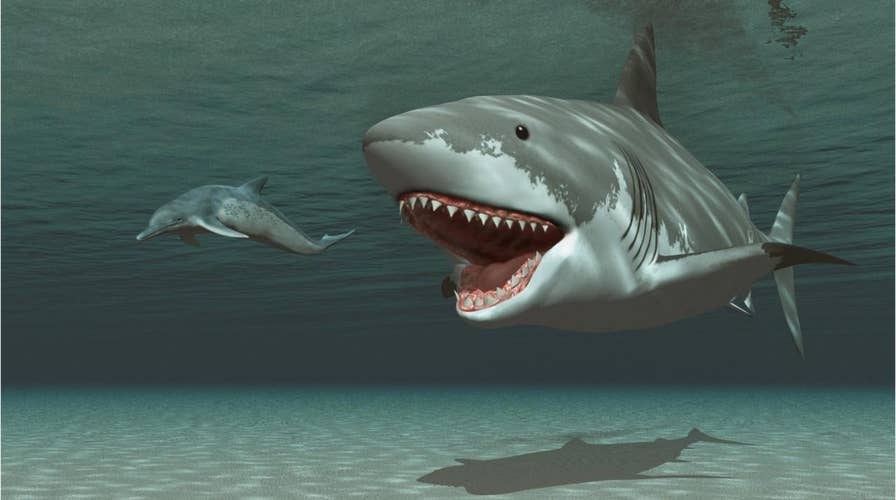Megalodons were the largest shark to ever live at nearly 60 feet in length. A new study suggests they may have reached such incredible sizes thanks to "cannibalistic" behavior before they were even born.
The research, published in Historical Biology, suggests that "early-hatched embryos" of these massive sharks may have eaten other eggs while still inside their mothers' bodies.
“This is compelling evidence for the truly exceptional size of megalodon,” study co-author Michael Griffiths said in a statement.

Schematic drawing showing the distribution of maximum possible sizes of all known 70 non-planktivorous genera (groups) in the shark order Lamniformes, comprising modern (in gray) and extinct (in black; with hypothetical silhouettes) members and in comparison with an average adult human (in red) as scale. (Kenshu Shimada, DePaul University)
MEGALODON DISCOVERY: SCIENTISTS REVEAL GIANT SHARK'S ASTONISHING TRUE SCALE
The researchers looked at the megalodon's modern relatives, known as lamniform (a group that includes great white sharks, makos and sand tiger sharks) due to similar diets and body types. They measured the teeth of these modern sharks to come up with their findings.
“Lamniform sharks have represented major carnivores in oceans since the age of dinosaurs, so it is reasonable to assert that they must have played an important role in shaping the marine ecosystems we know today,” the study's lead author, Kenshu Shimada, added.
In November 2019, a species of shark newly discovered by science with in-utero "cannibalistic behavior" was discovered in Kansas.
In September, a separate group of researchers determined the true size of the megalodon’s body, including its huge fins, based on fossils. A 52.5-foot-long megalodon likely had a head 15.3 feet long, a dorsal fin approximately 5.3 feet tall and a tail around 12.6 feet high, the scientists found.
Teeth of the monster of the deep that have been found are typically larger than a human hand, the researchers added. In recent memory, megalodon teeth have been found in North Carolina, South Carolina and Mexico.
In March 2019, a study suggested the giant shark spent millions of years evolving its teeth before they took their iconic form.
MEGALODON SHOCKER: HUGE KILLER SHARK MAY HAVE BEEN WIPED OUT BY GREAT WHITES
Scientists continue to learn more about the history of sharks, which have survived all five global extinction events.
In February, researchers discovered a variant of the great white that lives in the Mediterranean has been around for 3.2 million years, significantly longer than experts previously thought.
The megalodon may have become extinct thanks to being outmaneuvered and outdone by its smaller, more agile cousin, the great white.
PREHISTORIC SHARK WITH 'SPACESHIP-SHAPED TEETH' DISCOVERED ALONGSIDE MOST FAMOUS TYRANNOSAURUS
Other theories suggest the megalodon was killed off by an exploding star approximately 2.6 million years ago.
Another theory that has gotten a lot of attention in recent memory is that the megalodon simply was unable to regulate its body temperature. Cooler ocean temperatures during the Pliocene era led its preferred food, whales, to adapt, while the megalodon was unable.
During the Pleistocene extinction event, many animals larger than 80 pounds went extinct, according to the Illinois State Museum. At roughly 50 feet in length and a weight approaching 120,000 pounds, megalodons would have been a prime candidate to be affected by the cosmic blast.









































